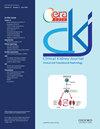运输式、便携式、穿戴式和(部分)植入式血液透析系统:技术和就绪程度比较
IF 4.6
2区 医学
Q1 UROLOGY & NEPHROLOGY
引用次数: 0
摘要
背景透析方式及其各种治疗方案是医疗、财务、技术、人体工程学和生态因素之间复杂妥协("权衡")的结果。本研究旨在总结这些权衡因素对(跨)便携式、可穿戴式甚至(部分)植入式血液透析(HD)系统的相互影响,确定哪些系统正在开发中,以及它们如何改善肾衰竭患者的生活质量(QoL)。方法 根据国际标准 IEC 60601-2-16 对血液透析的定义,对有关(半)便携式、可穿戴式和(部分)植入式血液透析系统的 PUBMED 数据库进行查询。在 159 项搜索结果中,有 24 项被纳入并扫描了特定的血液透析设备和/或开发中的血液透析系统。通过互联网和/或与制造商联系,收集了有关重量、尺寸和开发状态的其他信息。国际航空手提行李标准构成了可移动和便携的界限。技术就绪水平(TRL)是结合欧盟和北约医务人员的 TRL 标准确定的。查询结果显示了 13 个设备/项目:7 个可移动(6xTRL9,1xTRL5);2 个便携(1xTRL6-7,1xTRL4);2 个可穿戴(1xTRL6,1xfrozen);2 个部分植入(1xTRL4-5,1xTRL2-3)。讨论 主要分为 3 类技术方法:单通道、透析液再生和带有体外透析液再生功能的植入式血液透析过滤器(按流动性攀升顺序排列)。结论 肾脏通过排泄高浓度的废物溶质来促进流动性,同时尽量减少水分流失。模仿肾脏的这种功能可以提高血液透析系统的流动性。透析液再生血液透析系统可提高便携性/耐磨性,与耐用的植入式血液透析过滤器(一旦面世)相结合,可实现无针或无血管内导管的血液透析。但资金短缺严重阻碍了这一进程。本文章由计算机程序翻译,如有差异,请以英文原文为准。
Transportable, portable, wearable and (partially) implantable hemodialysis systems: comparison of technologies and readiness levels
Background Dialysis modalities and their various treatment schedules result from complex compromises (‘trade-offs’) between medical, financial, technological, ergonomic and ecological factors. This study targets summarizing the mutual influence of these trade-offs on (trans)portable, wearable or even (partially) implantable hemodialysis (HD) systems, identify what systems are in development, and how they might improve Quality-of-Life (QoL) for kidney failure patients. Methods Hemodialysis as defined by international standard IEC 60601–2-16 was applied on a PUBMED database query regarding (trans)portable, wearable and (partly) implantable HD systems. 24 out of 159 search results were included and scanned for specific HD devices and/or HD systems in development. Additional information about weight, size and development status was collected via internet and/or contacting manufacturers. International airplane hand baggage criteria formed the boundary between transportable and portable. Technology Readiness Levels (TRLs) were assigned by combining TRL-scales from the European Union and NATO medical staff. Results The query revealed 13 devices/projects: 7 transportable (6xTRL9, 1xTRL5); 2 portable (1xTRL6-7, 1xTRL4); 2 wearable (1xTRL6, 1xfrozen); and 2 partly implantable (1xTRL4-5, 1xTRL2-3). Discussion 3 main categories of technical approaches were distinguished: Single-pass, Dialysate regenerating, and Implantable HD filter with extracorporeal dialysate regeneration (in climbing order of mobility). Conclusions Kidneys facilitate mobility by excreting strongly concentrated waste solutes with minimal water loss. Mimicking this kidney function can increase HD system mobility. Dialysate regenerating HD systems are enablers for portability/wearability and, combined with durable implantable HD filters (once available), they may enable HD without needles or intravascular catheters. But lack of funding severely hampers progress.
求助全文
通过发布文献求助,成功后即可免费获取论文全文。
去求助
来源期刊

Clinical Kidney Journal
Medicine-Transplantation
CiteScore
6.70
自引率
10.90%
发文量
242
审稿时长
8 weeks
期刊介绍:
About the Journal
Clinical Kidney Journal: Clinical and Translational Nephrology (ckj), an official journal of the ERA-EDTA (European Renal Association-European Dialysis and Transplant Association), is a fully open access, online only journal publishing bimonthly. The journal is an essential educational and training resource integrating clinical, translational and educational research into clinical practice. ckj aims to contribute to a translational research culture among nephrologists and kidney pathologists that helps close the gap between basic researchers and practicing clinicians and promote sorely needed innovation in the Nephrology field. All research articles in this journal have undergone peer review.
 求助内容:
求助内容: 应助结果提醒方式:
应助结果提醒方式:


